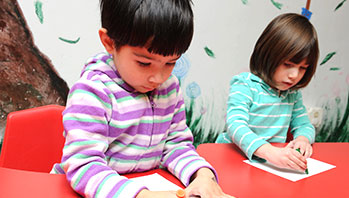- chart paper
- marker
- versions of the The Three Little Pigs book children have been reading: The Three Little Javelinas (book), Tell the Truth, B. B. Wolf (book), the class version “Our Three Little Pigs”
- adobe
- brick
- built
- cactus
- desert
- house
- pig
- sorry
- stick
- straw
- truth
- tumbleweed
- wolf
MA Standards:
English Language Arts/Writing/W.PK.MA.2 Use a combination of dictating and drawing to explain information about a topic.
Head Start Outcomes:
Language Development/Expressive Language Uses language to express ideas and needs.
Literacy Knowledge/Early Writing Recognizes that writing is a way of communicating for a variety of purposes, such as giving information, sharing stories, or giving an opinion.
PreK Learning Guidelines:
English Language Arts/Composition 16 Use their own words or illustrations to describe their experiences, tell imaginative stories, or communicate information about a topic of interest.
Draw and Write Together: Compare Versions of The Three Little Pigs

© Commonwealth of Massachusetts, Department of Early Education and Care (Jennifer Waddell photographer). All rights reserved.
ELA Focus Skills: Recall and Retell, Story Comprehension, Sequencing, Vocabulary
Remind children that throughout this unit they have seen and read different versions of the three little pigs’ story.
- Look at the books and the children’s story and ask children to recall the video.
- Talk about the different versions. Invite volunteers to give short retellings of each one.
- Create a “Same/Different” chart. Remind children that one column is for how the stories are alike and the other is for how they are different.
- Invite children to suggest entries for the chart. Use illustrations in the books to help children remember story details.
- Add responses to the chart. Then ask, How are all the versions alike? What do you think is the most important difference in each version?
Encourage children who have read other versions of the story from the browsing box in the Library Center to tell the name of the book and any likenesses or differences to add to the chart. When you are finished, read the entire chart with children, tracking the words as you do.
Adaptation: If very young children have trouble recalling all the stories, guide them by comparing the new story with one old one by giving a clue, For example, ask, Did the wolf do something nice in this book?
English Language Learners: If English language learners have trouble putting their ideas into words, let them pantomime; then you can explain what words to use.
